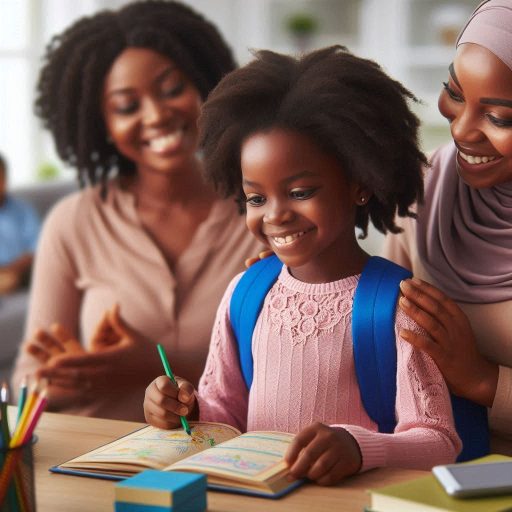Introduction
Kids home learning techniques play a crucial role in a Nigerian child’s education.
It offers opportunities beyond the constraints of the classroom.
Parents can enhance their children’s knowledge through guided learning activities.
This approach helps bridge gaps created by traditional education methods.
Traditional education in Nigeria faces several challenges.
Many schools struggle with inadequate resources and overcrowded classrooms.
Teachers often lack the training necessary to provide effective instruction.
Consequently, children miss out on fundamental skills and knowledge.
Home learning can counteract these shortcomings and provide alternative pathways to success.
This blog post aims to explore effective home learning techniques for Nigerian kids.
We will provide practical strategies that parents can easily implement.
These techniques will encourage creativity, critical thinking, and independent learning.
By leveraging everyday resources, parents can make learning enjoyable and interactive.
By understanding the importance of home learning, parents can actively participate in their children’s education.
Together, they can create a supportive environment that nurtures curiosity and a love for learning.
Understanding Home Learning
Definition of Home Learning and Its Significance
Home learning encompasses all educational activities that occur outside the traditional classroom.
It includes activities like reading, homework, and projects.
This concept allows children to learn at their own pace in a familiar environment.
The significance of home learning lies in its ability to support children’s education.
It fosters independent learning, encourages curiosity, and allows for personalized education.
By engaging in home learning, children reinforce what they learn in school and develop essential life skills.
Differences Between Home Learning and Traditional Classroom Learning
Home learning and traditional classroom learning have notable differences.
Understanding these distinctions can clarify the advantages of home learning for Nigerian children.
Below are some key differences:
- Learning Environment: Home learning takes place in a comfortable, familiar setting.
In contrast, classroom learning occurs in a structured, formal space. - Learning Pace: Children can learn at their own pace during home learning.
Classroom settings often follow a fixed schedule, which may not accommodate individual learning speeds. - Teacher Interaction: In classrooms, teachers manage large groups of students.
At home, kids can engage one-on-one with parents or guardians. - Resources: Home learning allows children to utilize diverse resources, including books, videos, and online materials.
Meanwhile, classrooms may have limited resources based on the school’s budget. - Flexibility: Home learning is flexible and can adapt to children’s schedules.
Conversely, classroom learning adheres to strict time tables and routines.
Benefits of Home Learning for Nigerian Kids
Nigerian kids can reap numerous benefits from engaging in home learning.
These advantages extend beyond academic performance and contribute to holistic development.
Here is a list of significant benefits:
- Enhanced Learning Opportunities: Home learning provides additional opportunities to explore subjects in-depth.
Children can pursue their interests beyond the school curriculum. - Development of Self-Motivation: Independent learning fosters self-motivation.
Kids learn to take initiative in their educational journey. - Improved Academic Performance: Regular home learning helps reinforce classroom lessons.
This practice often leads to better grades and a deeper understanding of the material. - Stronger Family Bonds: Involving families in the learning process strengthens bonds.
This collaborative effort encourages discussions about learning topics. - Adaptation to Learning Styles: At home, children can adapt learning strategies that suit their individual styles.
This personal approach enhances engagement and retention. - Greater Access to Technology: Many homes possess devices that facilitate learning.
Kids can access educational resources like e-books, videos, and online courses. - Encouragement of Critical Thinking: Home learning can stimulate critical thinking skills.
Children explore problems creatively and come up with unique solutions. - Flexibility in Learning Schedules: Parents can customize learning times.
This flexibility allows for better accommodation of family needs and lifestyle. - Promotion of Lifelong Learning: Early exposure to consistent home learning promotes a habit of lifelong learning.
Kids grow to value education throughout their lives. - Increased Confidence: Successfully mastering subjects at home builds confidence.
Kids become more assured in their abilities and willingness to participate in school.
In fact, understanding home learning’s significance offers valuable insights for parents and educators.
It stands as an essential complement to traditional classroom education.
Acknowledging the differences between these two forms of learning helps parents maximize their children’s educational experiences.
Through home learning, Nigerian kids can unlock their potential and gain lifelong skills that transcend the classroom.
Creating a Conducive Learning Environment
Creating a conducive learning environment at home is essential for children’s academic success.
A well-thought-out space can significantly enhance their focus and motivation.
Here are some key aspects to consider when designing a home learning area for Nigerian kids.
Importance of a Designated Learning Space at Home
Having a specific area for learning can help children mentally separate this space from relaxation and play.
It reinforces the idea that this space is dedicated to learning.
Here are several reasons why it matters:
- Establishes Routine: A designated learning space cultivates routine and discipline.
- Improves Focus: An organized area minimizes interruptions, allowing kids to concentrate.
- Encourages Independence: Children learn to take responsibility for their studies in a designated area.
- Boosts Motivation: A well-defined space can channel excitement and motivation towards learning.
- Reflection of Commitment: A specific learning area shows that education is valued at home.
Tips for Organizing and Personalizing the Learning Area
Creating a personalized learning area can make it feel special and inviting.
These tips can help you organize and personalize the space effectively:
- Choose the Right Location: Select a quiet room with minimal foot traffic.
Natural light enhances the mood and focus. - Invest in Good Furniture: A sturdy desk and comfortable chair are essential.
Ergonomic designs support better posture while studying. - Incorporate Educational Tools: Stock the area with books, stationery, and learning resources.
These materials should be within arm’s reach. - Display Achievements: Showcase the child’s accomplishments, like certificates or artwork.
This provides motivation and builds confidence. - Create a Study Schedule: Post a visual timetable that outlines daily tasks and learning goals.
This helps establish structure and routine. - Add Personal Touches: Let your child personalize the space with favorite colors or themes.
This encourages ownership and enthusiasm. - Incorporate Technology: If applicable, set up a computer or tablet for educational purposes.
Limit access to distracting apps or websites. - Keep it Organized: Use storage bins, shelves, and organizers to keep the area tidy.
Regular clean-up sessions foster responsibility.
Minimizing Distractions for Better Focus
Distractions can severely hinder learning progress.
It’s crucial to identify and minimize these distractions.
Here’s how to create a focused environment:
- Limit Noise: Choose a quiet spot in the house.
If necessary, use noise-cancelling headphones or calming music. - Turn Off Devices: Put away phones and entertainment devices during study time.
This eliminates digital distractions. - Establish Clear Boundaries: Instruct family members and friends not to interrupt study time.
Respect for the learning area is essential. - Encourage Breaks: Schedule short breaks for kids to recharge.
This helps maintain long-term focus and productivity. - Create a Distraction-Log: If distractions arise, keep a log of them.
Address these issues to optimize the study environment. - Use Visual Reminders: Place reminders in the space that promote focus and motivation.
Positive quotes can be inspiring. - Limit Clutter: A clean and organized space diminishes confusion.
Regularly check and remove unnecessary items. - Encourage Mindfulness: Teach kids mindfulness techniques to enhance focus.
Simple breathing exercises can help center their thoughts.
In short, a conducive learning environment is vital for Nigerian kids.
By establishing a designated study space, organizing the area, and minimizing distractions, you can foster a love for learning.
Your support in creating this environment is invaluable for your child’s educational journey.
Emphasize the importance of focus, and provide the necessary tools and encouragement for success.
The right learning space can ignite curiosity and creativity, helping them thrive in and beyond the classroom.
Read: Smart Parenting: Best Educational Practices for Nigerian Kids
Parenting Made Just for You
Get personalized Parenting Solutions tailored to your child’s needs. Transform your parenting journey with expert guidance in 1-3 days.
Get StartedIncorporating Play in Learning
Incorporating play into learning offers numerous benefits for children, especially for Nigerian kids who thrive in a vibrant cultural environment.
Educational games and play can significantly enhance cognitive development, making learning engaging and effective.
Here’s how you can effectively use play in learning.
The Role of Educational Games and Play in Cognitive Development
Play serves as a fundamental avenue for children to explore and engage with the world around them.
Through games and structured play, kids develop essential cognitive skills, including:
- Problem-Solving Skills: Games often require children to think critically, analyze situations, and devise strategies.
- Creativity: Many games stimulate imaginative thinking, encouraging kids to think outside the box.
- Social Skills: Participating in team games fosters cooperation, communication, and negotiation skills.
- Attention Span: Engaging in focused play helps improve concentration and attention to detail.
- Memory: Many games require recalling rules, strategies, or previous moves, enhancing memory retention.
In Nigeria, blending local cultural elements with learning can facilitate cognitive development through playful interactions.
By incorporating local languages, folklore, and traditional knowledge in games, kids can connect learning with their heritage.
Examples of Local Games Promoting Learning
Nigeria boasts a rich tapestry of traditional games that can stimulate mind and body.
Here are several local games that offer educational benefits while being fun:
- Ayo: A traditional board game played with seeds and a wooden board.
Ayo teaches counting, strategy, and critical thinking. - Ludu: This popular board game is an excellent way to teach turn-taking, basic arithmetic, and strategic planning.
- Oware: Another counting game that promotes mathematical skills.
It requires players to create strategies based on available moves. - Traditional Storytelling: Although not a game, it includes interactive elements where kids can act out narratives, enhancing language skills and creativity.
- Football: While it is a sport, playing football teaches teamwork, discipline, and goal orientation.
Both strategic planning and physical fitness come into play.
These games not only entertain but also promote various educational aspects.
They promote teamwork, decision-making, and abstract thinking.
Balancing Structured Learning with Recreational Activities
Finding a balance between structured learning and recreational activity is crucial for effective education.
Both methodologies complement each other, creating a well-rounded learning environment.
Here are ways to maintain this balance:
- Set Time for Educational Games: Dedicate specific times for educational games.
This fosters a routine that values learning through play. - Integrate Play into Learning: Use educational games to introduce new concepts.
For example, use board games to teach math or language skills. - Encourage Outdoor Play: Engage kids with traditional outdoor games that develop physical skills and promote social interaction.
- Create a Learning Schedule: Mix academic lessons with playtime to keep children engaged and prevent burnout.
- Involve Family and Friends: Encourage group games that promote family learning experiences.
This heightens social learning. - Reflect on Learning: After play, encourage discussions on lessons learned.
This reinforces concepts learned during play.
Integrating structured learning with recreational activities offers children various pathways to engage in education.
It ensures that learning stays relevant, enjoyable, and applicable to real-life situations.
For Nigerian kids, education does not have to be monotonous or strictly academic.
By incorporating play into learning, you can foster a love for education that transcends classroom boundaries.
This thoughtful approach nurtures well-rounded individuals equipped with skills necessary for personal and academic success.
Ultimately, effective home learning hinges on combining play with traditional learning methodologies.
Empowering children to learn through play supports their growth, enhances their cognitive abilities, and builds a robust foundation for lifelong learning.
These approaches ensure that education is enjoyable and holistic, creating engaged learners ready to face the future.
Read: Educational Milestones: A Nigerian Parent’s Guide to Schooling
Utilizing Technology for Home Learning
In today’s digital age, technology offers vast opportunities for enhancing home learning experiences for Nigerian children.
Parents can utilize various digital resources to support their children’s education effectively.
Overview of Digital Resources Available
Many educational apps and online courses cater to different subjects and age groups.
These resources make learning interactive and fun.
Here’s a list of some popular categories:
Educational Apps
- Khan Academy Kids: A free app that covers a wide range of subjects for preschool to early elementary students.
- Duolingo: A gamified platform to help children learn new languages through interactive lessons.
- Prodigy Math: A math game that adapts to a child’s skill level, making math practice enjoyable.
- Quizlet: An app that allows children to create and study flashcards.
It promotes memorization and learning.
Online Courses
- Coursera: Offers various courses in subjects like coding, science, and humanities.
- edX: Provides access to university-level courses suitable for older children and teens.
- FutureLearn: Features a wide range of free courses from universities worldwide, including topics relevant to Nigerian culture.
YouTube Educational Channels
- Cgpgrey: Engaging videos explaining various topics in history and science.
- CrashCourse: Offers a series of courses on various subjects, making learning visually appealing.
- TED-Ed: Provides animated lessons on a wide range of topics, encouraging critical thinking.
- Learn with Engage: Focuses on Nigerian curriculum subjects and localized content.
Importance of Internet Safety and Guidance for Parents
While the internet offers fantastic resources, safety remains a top concern.
Here’s what parents should keep in mind:
- Monitor Usage: Regularly check what your child engages with online.
Knowing their activities helps avoid harmful content. - Educate About Privacy: Teach children about the importance of protecting their personal information online.
Explain why they should avoid sharing personal details. - Set Clear Boundaries: Establish rules regarding screen time and acceptable websites.
Encourage balanced online and offline activities. - Use Parental Controls: Enable parental control settings on devices and browsers.
These help filter out inappropriate content. - Encourage Open Communication: Foster an environment where your children feel comfortable discussing their online experiences.
This can help them approach you with any concerns.
Local Platforms Providing Tailored Content for Nigerian Children
Several local platforms specifically offer educational content designed for Nigerian children.
These resources align with the national curriculum, promoting relevant learning. Here’s a list of notable platforms:
Unveil the Perfect Name that Tells Your Family's Story
Let us help you find a name that embodies your family's values, traditions, and dreams. Our personalized consultation weaves cultural insights to create a name that's uniquely yours.
Get Started- Edu360: An online learning platform providing comprehensive lessons for all subjects in the Nigerian curriculum.
- LearnHub: Allows children to access a variety of video lessons, quizzes, and interactive resources tailored for Nigeria.
- Naija Kids: Offers African-centric content designed to promote cultural understanding and awareness in young learners.
- MySchoolGist: Provides educational news and resources related to school curriculums and examinations in Nigeria.
- Tutors.ng: Connects students with qualified tutors for personalized lessons across various subjects.
How to Incorporate Technology in Daily Learning
To make the most of these resources, set a structured schedule.
Here are some suggestions:
- Daily Screen Time: Allocate specific times for educational apps and online courses.
Consistency creates a stable learning environment. - Interactive Family Sessions: Involve the whole family in online learning, creating discussions around what children explore.
This encourages collaboration. - Project-based Learning: Encourage children to use online resources to engage in projects.
This practical approach deepens understanding. - Follow Up with Offline Activities: Complement online learning with hands-on activities.
For instance, a cooking session can teach measurements, and a gardening project can cover biology topics.
Utilizing technology for home learning can significantly enhance the educational experience for Nigerian children.
By understanding the digital resources available and implementing safety precautions, parents can foster a rich learning environment.
Local platforms provide tailored content, while structured use of technology can lead to effective learning outcomes.
Balance and communication will ensure children thrive academically in the digital age.
Read: The ABC of Nigerian Education: A Guide for Smart Parents

Adapting Local Culture to Learning
Incorporating local culture into home learning not only nurtures children’s education but also promotes their identity.
By integrating Nigerian history, culture, and languages into the learning process, we reinforce the values and traditions that shape who they are.
This approach provides kids with relevant and relatable content, making learning engaging and meaningful.
Integrating Nigerian History, Culture, and Languages Into Home Learning
Teaching Nigerian history, culture, and languages at home creates a richer educational experience.
Here are several ways to achieve this integration:
- Utilize bilingual resources: Use books, videos, and audio materials that incorporate both English and local languages.
This practice enhances language skills and fosters a sense of belonging. - Highlight historical events: Discuss significant events in Nigerian history with children, providing context and connection to their own lives.
- Celebrate cultural festivals: Engage kids in the celebration of cultural festivals.
Explain their significance and history, helping children to understand their importance. - Explore local traditions: Teach children about local customs and traditions.
Share stories behind these practices to build appreciation for their heritage.
By embedding these elements into daily learning, parents can develop an appreciation for Nigerian culture in their children.
Using Local Stories, Folklore, and Art for Educational Purposes
Local stories and folklore are treasure troves of lessons and morals.
They provide insight into the values and beliefs of Nigerian society.
Here are ways to leverage these narratives:
- Storytelling sessions: Organize regular storytelling sessions featuring local folk tales.
Use these stories to teach valuable life lessons and moral principles. - Drama and role-play: Encourage children to act out stories or folklore.
This activity enhances their creativity while deepening their understanding of cultural narratives. - Art projects: Use local art forms such as painting and sculpture to express stories.
Art projects can help in discussing cultural themes and histories while making learning hands-on. - Writing prompts: Encourage children to write their versions of traditional stories.
This exercise promotes literacy and critical thinking skills.
Integrating art and storytelling into the learning process inspires creativity and critical analysis.
Encouraging Cultural Activities That Enhance Learning
Cultural activities provide unique opportunities for experiential learning.
These activities can enrich children’s understanding of their environment.
Here are some ideas to consider:
- Cooking traditional dishes: Involve children in preparing traditional Nigerian meals.
Use this activity to discuss the origins and significance of these dishes in Nigerian culture. - Music and dance: Introduce children to Nigerian music and dance.
Teach them traditional songs and dances to connect them with their cultural roots. - Cultural field trips: Plan visits to local museums, cultural centers, or historical sites.
This exposure deepens their contextual understanding of their heritage. - Crafting traditional items: Engage kids in creating traditional crafts, like beadwork or tie-dye.
This hands-on approach helps them appreciate artistic expressions of their culture.
Encouraging these activities not only fosters a love for learning but also strengthens cultural identity.
The Importance of Cultural Sensitivity
It is vital to approach cultural education with sensitivity. Here are some key considerations:
- Respect varied backgrounds: Acknowledge the diversity within Nigerian culture.
Teach children that different regions have distinct practices and traditions. - Avoid stereotypes: Educate against stereotypes when discussing cultural elements.
Provide balanced perspectives that showcase the richness of Nigerian culture. - Encourage open dialogue: Foster an environment where children can ask questions and express their views about culture.
This openness promotes understanding and depth in discussions.
By maintaining cultural sensitivity, parents can effectively educate their children without perpetuating misconceptions.
Fostering a Love for Learning Through Cultural Engagement
Encouraging cultural engagement can create an environment where children love to learn.
Here are strategies to promote this love:
- Celebrate progress: Acknowledge and celebrate small achievements in learning about culture.
Recognition boosts confidence and interest. - Incorporate fun activities: Make learning fun by incorporating games and competitions related to cultural knowledge.
- Provide resources: Equip children with various resources, such as books, documentaries, and articles that focus on Nigerian culture.
- Be a role model: Show enthusiasm for learning and cultural exploration.
Your passion will inspire your children to engage more deeply.
When kids see their parents take joy in learning, they are more likely to adopt a similar attitude.
This approach lays a foundation for lifelong learning.
Integrating local culture into home learning empowers Nigerian children.
It strengthens their identity while enhancing educational experiences.
By using stories, folklore, and cultural activities, parents can create rich learning environments.
Cultivating an appreciation for local culture ensures that children not only learn but also respect and preserve their heritage.
These strategies foster a love for learning that transcends the classroom.
Together, we can instill pride in our young ones, shaping them into well-rounded and culturally aware individuals.
Read: Smart Parenting: Maximizing the Education of Your Child in Nigeria
Engaging Family Members in the Learning Process
Engaging family members in the learning process is vital for children’s academic and social development.
This approach builds a sense of community around education.
By involving siblings and extended family, you can create a rich learning environment.
Here are some strategies for doing just that.
Strategies for Involving Siblings and Extended Family
Encouraging family participation in learning helps reinforce concepts and fosters a supportive environment.
Here are some effective strategies:
- Create Family Study Groups: Organize study sessions where siblings collaborate on homework or projects.
This encourages teamwork and allows kids to learn from one another. - Incorporate Family Games: Use educational games that involve the entire family.
Games like Scrabble or trivia can make learning fun and interactive. - Assign Roles: Designate specific roles for each family member in learning activities.
For example, one person can be the researcher, while another prepares presentations. - Family Book Club: Start a family book club where everyone reads the same book.
This encourages dialogue, comprehension, and critical thinking. - Invite Extended Family: Invite uncles, aunts, or cousins to participate in learning activities.
They can offer different perspectives and resources. - Utilize Technology: Use video calls to include distant family members in discussions or study sessions.
This maintains engagement regardless of location.
Benefits of Collaborative Projects and Group Studies
Collaborative projects and group studies enhance learning in multiple ways.
They provide children with essential life skills that extend beyond academics.
Here are some benefits:
- Enhanced Understanding: Collaborative work allows children to explain topics to each other.
Doing this strengthens their understanding and retention of information. - Development of Social Skills: Working in groups helps children develop communication and teamwork skills.
They learn to express themselves and listen to others. - Increased Motivation: Sharing learning experiences with family members boosts motivation.
Children are less likely to feel isolated when learning together. - Physical Engagement: Collaborative projects often involve hands-on activities.
Physical engagement aids concentration and makes learning more memorable. - Support and Encouragement: Family members provide emotional support during tough learning moments.
This encouragement can significantly improve a child’s attitude towards learning. - Boosted Creativity: Collaborating on projects encourages creativity.
Different ideas from various family members can lead to innovative solutions.
Tips for Maintaining a Supportive Network Within the Family
To maintain a supportive learning network, families need to establish communication and understanding.
Here are some tips to consider:
- Regular Family Meetings: Hold weekly or biweekly meetings to discuss academic progress.
This creates an open atmosphere where everyone can share their thoughts. - Set Goals Together: Set educational goals as a family.
Make sure everyone understands their responsibilities and the importance of reaching these goals. - Celebrate Achievements: Acknowledge and celebrate both small and big wins.
This helps motivate children to continue working hard in their studies. - Be Open-Minded: Encourage open dialogue about educational topics.
Allow children to voice their opinions and ask questions without judgment. - Provide Resources: Share books, documentaries, and other educational materials.
Having access to varied resources helps broaden children’s understanding. - Model Positive Attitudes: Parents and older siblings should model positive attitudes toward education.
Show enthusiasm for learning to inspire others.
By incorporating the entire family into the learning process, you create a rich and nurturing environment for your child.
Engaging siblings and extended family fosters social skills, enhances understanding, and keeps children motivated.
When families come together for learning, academic success follows.
Ultimately, this collaborative approach not only benefits children academically, but also strengthens family bonds, making learning a collective and enjoyable experience.
Embrace these techniques to make education an integral part of your family life.
Monitoring Progress and Adjusting Techniques
Importance of Tracking Academic Progress and Milestones
Monitoring children’s academic progress plays a crucial role in effective home learning.
It helps parents and educators identify strengths and weaknesses early.
Tracking milestones boosts motivation and commitment to learning.
When children see their progress, they feel a sense of achievement.
This positivity encourages them to pursue further knowledge.
Establishing clear goals can aid in assessing children’s learning outcomes.
Celebrating small victories fosters a supportive learning environment.
Regularly reviewing progress also informs teaching methods and approaches.
Key Benefits of Tracking Progress
- Identifies Learning Gaps: Close examination reveals areas needing improvement.
- Encourages Goal Setting: Clear objectives motivate children to strive for success.
- Enhances Communication: Tracking creates opportunities for discussions about learning.
- Informs Instructional Adjustments: Understanding progress allows for tailored teaching methods.
- Increases Accountability: Kids become responsible for their learning through self-assessment.
Tools and Methods for Assessing Learning Outcomes
Families can utilize various tools and techniques to assess learning outcomes.
Adapting these methods to children’s needs fosters an engaging environment.
Some popular assessment tools include:
Quizzes and Tests
Regular quizzes help gauge understanding of recently learned material.
These can be formal or informal, covering a range of subjects.
Crafting quizzes with varying difficulty levels maintains engagement for all learners.
Discussions and Interactive Sessions
Engaging in discussions allows children to express their thoughts.
This method encourages critical thinking and reasoning.
Family discussions on topics of interest can enhance comprehension and retention.
Project-Based Assessments
Projects allow children to explore topics deeply.
Projects can include science experiments, creative arts, or research presentations.
This hands-on approach solidifies learning through practical application.
Observation and Anecdotal Records
Regular observations capture a child’s learning style and behavior.
Keeping anecdotal records enables the tracking of progress over time.
Parents can note achievements and areas needing improvement easily.
Digital Learning Platforms
Utilizing online platforms can aid in tracking progress efficiently.
Many educational websites offer built-in assessment tools.
These platforms often provide parents with performance insights and analytics.
Feedback Mechanisms
Providing timely feedback is vital for learning.
Parents should ensure they offer constructive criticism.
This promotes growth and encourages children to reflect on their work.
Self-Assessment Tools
Encouraging kids to assess their own work fosters independence.
Children can use checklists or reflection journals.
Self-assessment cultivates a growth mindset, vital for lifelong learning.
Flexibility to Adapt Styles and Methods
Each child possesses unique interests and learning styles.
Being flexible allows parents to adjust techniques based on their child’s needs.
Tailoring education methods leads to better engagement and understanding.
Understanding Different Learning Styles
Recognizing various learning styles can personalize education.
Here are the primary types of learning styles identified in children:
- Visual Learners: These children learn best through images and visual aids.
- Auditory Learners: These children prefer listening to instructions and discussions.
- Kinesthetic Learners: These children thrive in hands-on experiences and movement.
- Read/Write Learners: These children excel in written communication and textual resources.
Adjusting Techniques Based on Interests
Integrating children’s interests into learning keeps them engaged.
Here are some ideas for tailoring home learning:
- Incorporate Hobbies: Include subjects that align with children’s hobbies, like nature for budding scientists.
- Use Games: Turn lessons into games to make learning enjoyable.
Board games or online quizzes are excellent resources. - Student-Centered Projects: Allow children to choose project topics, emphasizing their interests.
- Utilize Technology: Use educational apps that captivate children’s attention and cater to their learning needs.
- Connect Learning to Real Life: Relate lessons to everyday experiences for relevance and better comprehension.
Monitoring progress and adjusting techniques is paramount for effective home learning.
Families can track academic progress through various methods and tools.
This ensures that children stay engaged and motivated in their learning journey.
Adapting to individual interests and learning styles further enhances this experience.
By embracing flexibility and fostering communication, parents can create a supportive environment for their children.
Ultimately, this adaptive approach encourages lifelong learning beyond the classroom.
Conclusion
Effective home learning techniques play a vital role in children’s education.
These methods reinforce classroom lessons and promote lifelong learning.
A supportive learning environment encourages kids to explore and grow intellectually.
Parents should recognize their influence on their children’s academic journeys.
By becoming proactive, parents can significantly enhance their children’s learning experiences.
Engage actively in your child’s education by creating a structured routine.
Set aside dedicated time for study and exploration each day.
Use resources such as books, educational games, and online platforms to enrich their learning.
Additionally, foster curiosity by encouraging questions.
Teach your children to seek answers through research and dialogues.
Encourage practical applications of knowledge, such as home experiments or community projects.
Such activities solidify their understanding of complex concepts.
Moreover, establish a positive and open atmosphere at home.
Celebrate achievements, no matter how small, to motivate continuous effort.
Create spaces in your home designated for study and creative activities.
This physical separation helps children associate those spaces with learning.
Furthermore, be a role model by demonstrating your love for learning.
Share your interests with your children, whether it’s reading a book or learning a new skill.
Your enthusiasm will inspire them to pursue knowledge independently.
Finally, remember that collaboration enhances learning. Involve other family members in educational activities.
This can strengthen family bonds while supporting your child’s educational journey.
By working collectively, you create a rich learning ecosystem.
Ultimately, the impact of a supportive learning environment extends far beyond the classroom.
It not only shapes academic success but also builds critical life skills.
When children receive encouragement and guidance at home, they thrive and flourish.
With your proactive involvement, you can empower your children to achieve their fullest potential.




